
项目位于成都天府新区,项目占地约9700平方米。位于麓客岛上岛前区,紧邻麓客岛新建游客中心,是天府美食岛一期复合游逛餐饮目的地的延续与升级。
The project is located in Chengdu Tianfu New Area with a total area of approximately 9700 square meters. It is situated in the pre-island area of Luxe Island, adjacent to the newly built tourist center of Luxe Island, and it is an extension and upgrade of the first phase of Tianfu Food Island, a complex dining and entertainment destination.
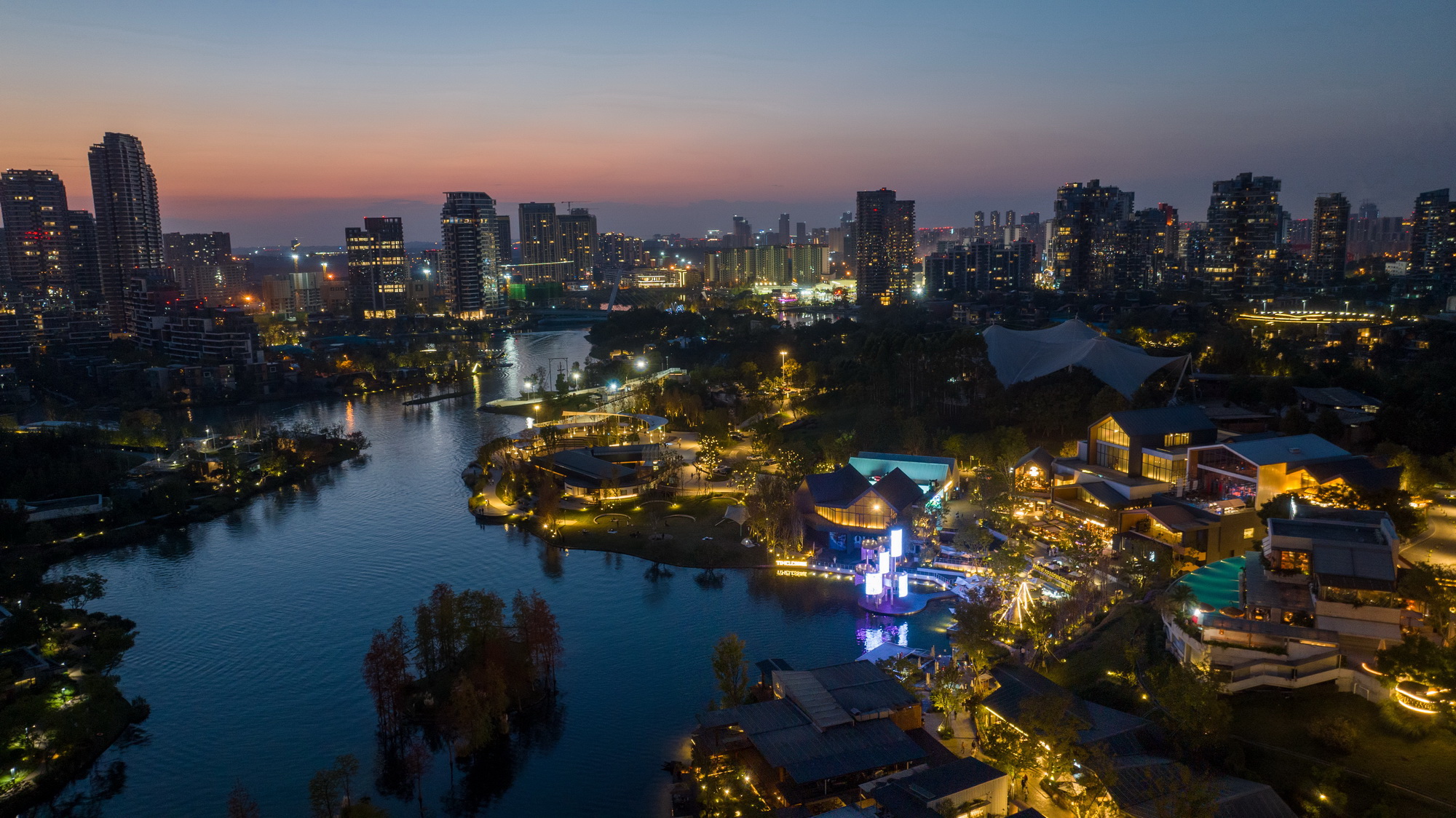
▲项目区位鸟瞰夜景
▲ Aerial night view of the project location
项目场地位于面湖内湾区,是连接主岛与岛前区场地的咽喉处,地形复杂且空间局促,需要解决必要的户外商业运营场地、公共活动空间、景区游客主动线、后勤及消防、停车等诸多功能需求,让复杂功能在这片不大的场地能有机布局、合理安排。
The project site is positioned in the inner bay area, facing the lake. It acts as a crucial connection between the main island and the pre-island area. The terrain is complex and the available space is limited, which presents challenges in accommodating various functional requirements such as outdoor commercial operation areas, public activity spaces, tourist routes within the scenic area, logistics and fire safety, and parking. The goal is to achieve a well-organized and rational layout of these diverse functions within the constrained space
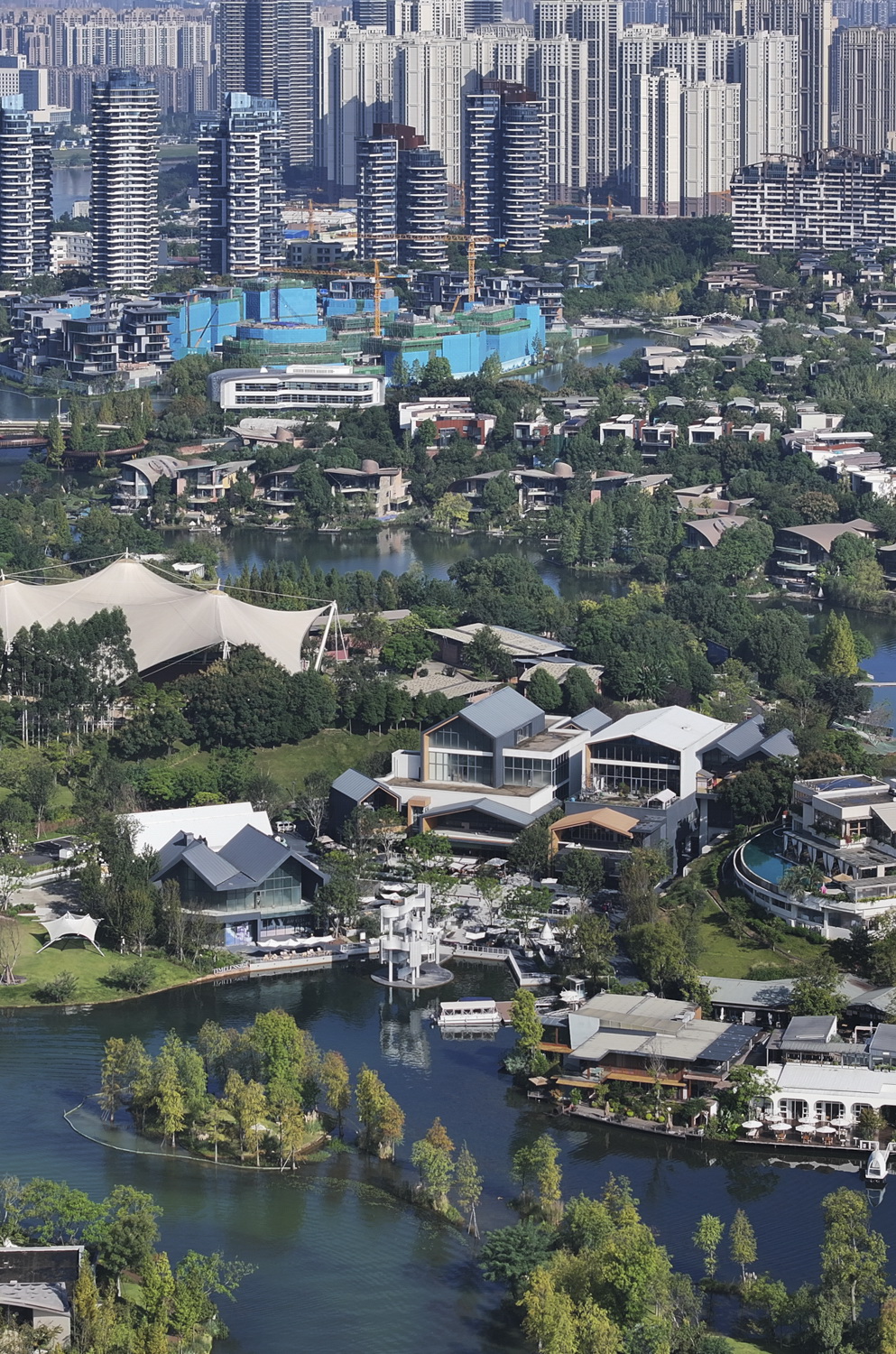
▲项目鸟瞰
▲ Aerial view of the project site
场地从山脊处车行道到湖畔,高差约12米,宽度约100米。临近美食岛一期有巨大岩壁,且高标高处已建大体量建筑,在初期规划及实施时有比较大的难度。
通过大量在与建筑专业配合协调的初期规划布局尝试后,空间框架落位,景观专业着手解决上文提到的诸多协调问题。
From the ridge of the site to the lakeside, there is a height difference of approximately 12 meters, spanning a width of about 100 meters. In close proximity to the first phase of the food island, there is a colossal rock wall and high-rise buildings have been constructed at elevated levels. These factors posed significant challenges during the initial planning and implementation stages.
After numerous planning attempts in collaboration with architectural professionals, a spatial framework was established, allowing landscape professionals to address the aforementioned coordination issues.
首先面临的问题是,地块最大化利用需要将一期与二期中间的岩壁进行护壁桩支撑施工,再将二期内山体开挖。由于地块面积有限,紧贴护壁桩一侧,开挖后形成下方是消防兼后勤通道,上方是一期业态的自然放坡。我们将开挖后的护壁桩板墙利用起来,间隔布置广告位板,用于作为商业、活动发布,配合工程兼顾运营。
One major challenge involved maximizing the land utilization. This required reinforcing the rock wall between the first and second phases with protective wall piles, as well as excavating the mountain in the second phase. Due to the limited land area, the excavation created a fire and logistics passage beneath the protective wall piles, while forming a natural slope for the business area of the first phase. The excavated protective wall piles were utilized by spacing them out and installing advertising boards for commercial and event announcements, taking operational requirements into consideration.
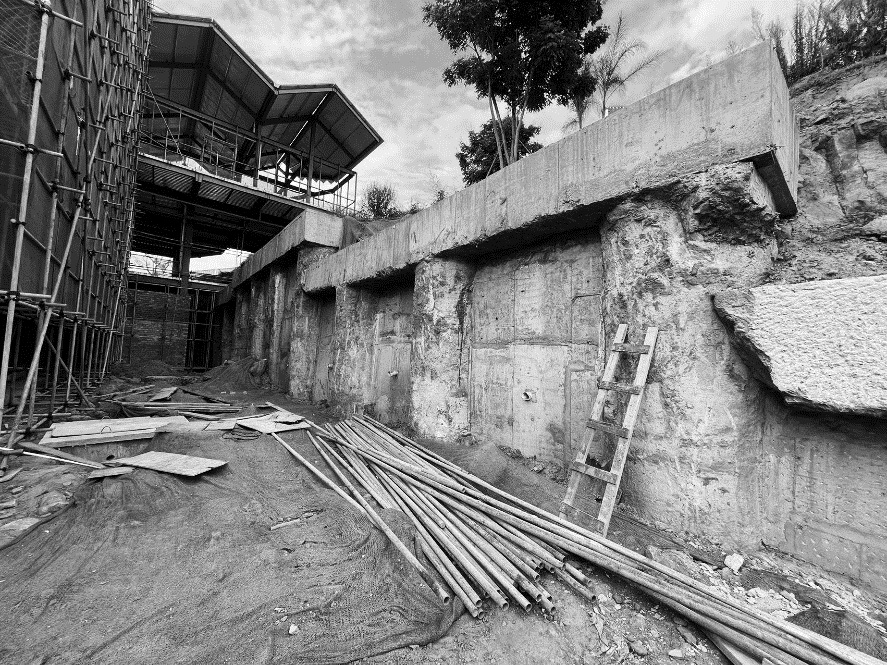
▲桩板墙成型状态
▲ Formation of the retaining pile wall
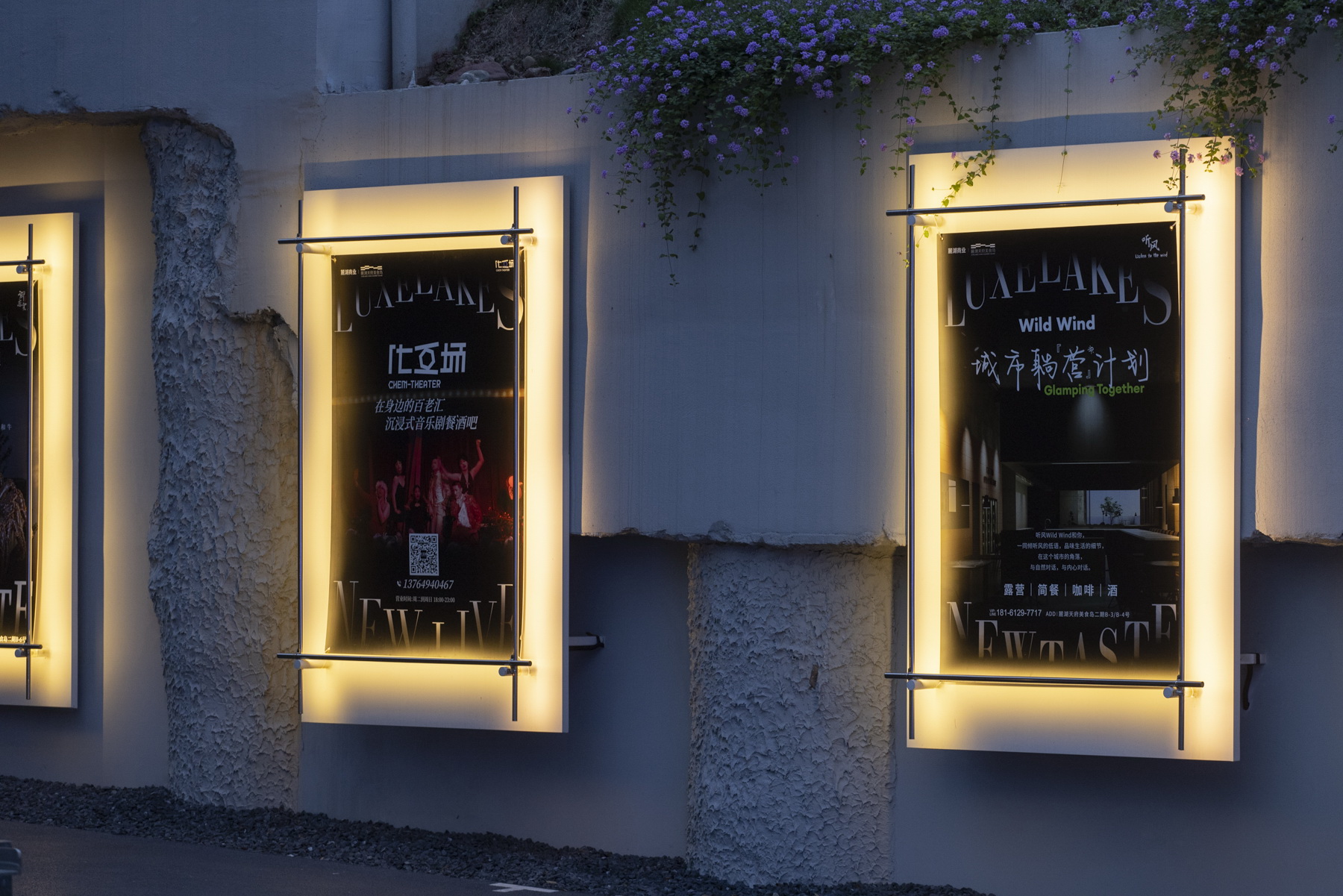
▲桩板墙完型状态
▲ Completed retaining pile wall
其次,需要在场地中解决商业对外摆的最大化需求,即临湖观景;同时,此湾区也是游客游览完美食岛一期后,进入麓客岛景区的必经通道。如何兼顾公共性和商业性,我们做了大量探讨。
最终,选择布置简洁明确的游客通道通向景区入口,分隔开的建筑内业态与临湖复合外摆区,则形成固定跟复合功能两部分商业外部区域。
Another challenge was to meet the demand for lakeside observation points while also serving as a passageway for visitors to enter the Laoke Isle scenic area after visiting the first phase of the food island. Extensive discussions were held on how to balance the public and commercial aspects.
Finally, a decision was made to establish a clear and concise visitor pathway leading to the entrance of the scenic area. The architectural formats were separated, and a combined indoor-outdoor space was created for commercial activities.
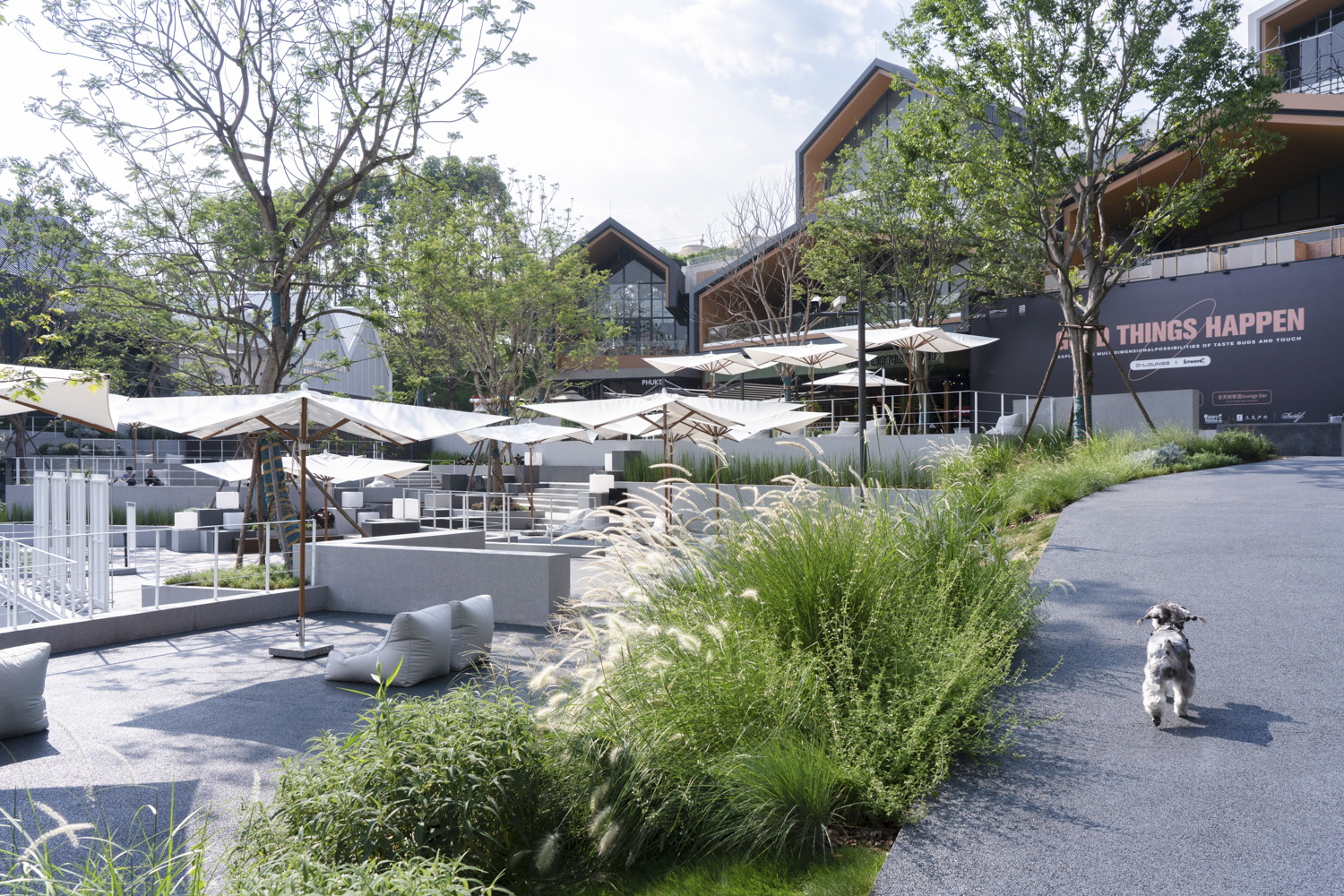
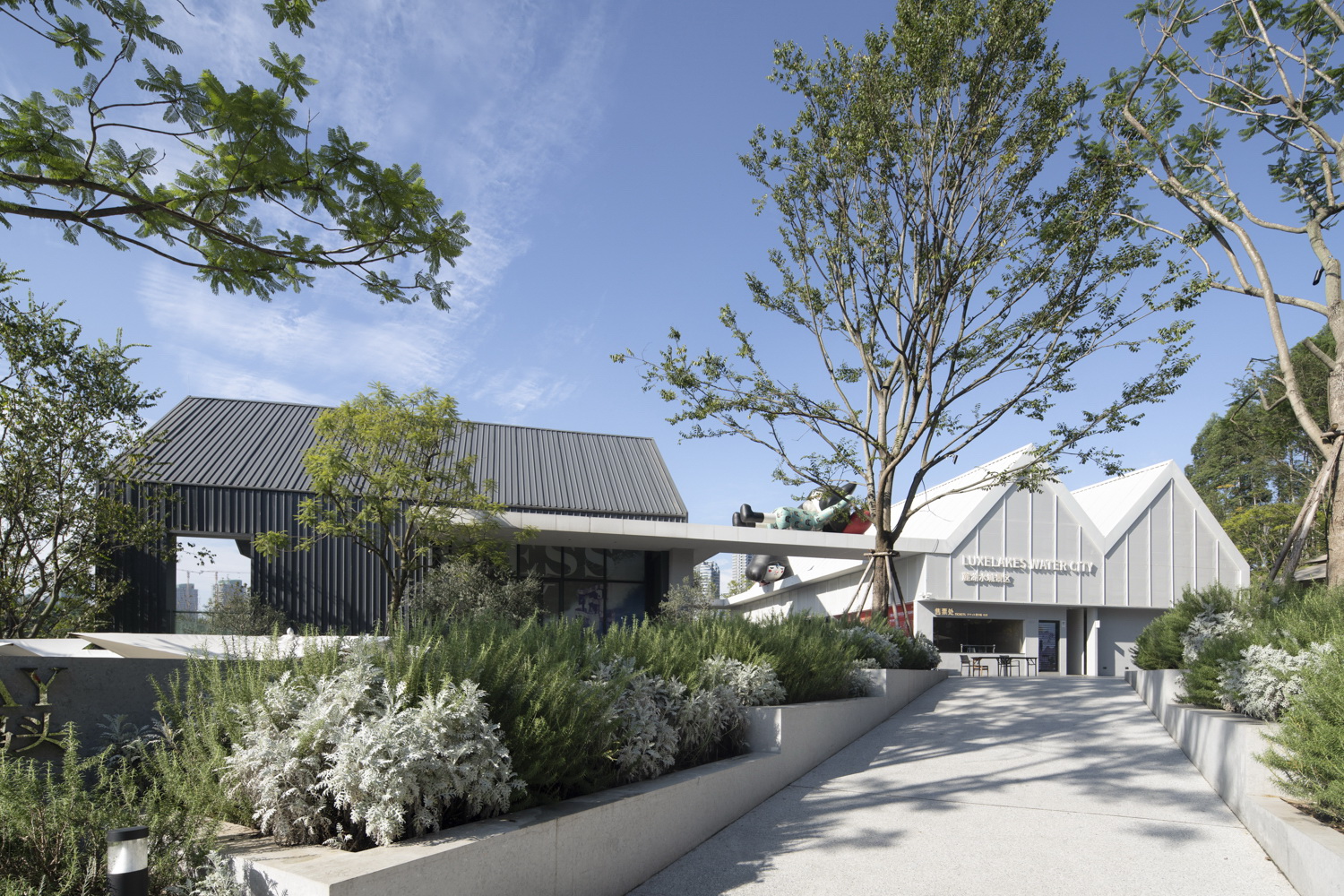
▲景区主要游览通道
▲ Main visitor route in the scenic area
另外,一个重要的项目轴线在于,从高处向湖滨径直延申的重要动线。规划之初,极致的场地条件让我们分析良久,最终将计就计,利用狭窄空间,以功能需求为主的场地形态为元素,形成从高标高处蹦落并通过狭窄通道,最终散布与滨湖区域的几何布置,强化高差带来的由窄而宽的大台阶,形成功能与形态兼具的轴线景观。
Furthermore, an important axis of the project extends directly from a high point to the lakeshore. During the initial planning stage, comprehensive analysis was conducted to determine the optimal site conditions. Ultimately, the limited space was utilized, focusing on the functional requirements, to create a distinct axis landscape that descends from a high point, passes through narrow passages, and eventually spreads out into a geometric layout in the lakeside area. This design enhances the experience of varying width brought by the height difference and achieves a balance between functionality and form.
其延续一期连通高标高道路及滨湖区域的重要纵向通道,在极致的建筑规划条件中,以集中的人行台阶动线串联两侧主力店灰空间的消极空间,形成友好的挂面铺,密切跟中轴动线进行商业形态交互。
This significant vertical passage connects the elevated road and the lakeside area of the first phase. Within the highly restricted architectural planning conditions, concentrated pedestrian step lines connect the main stores on both sides, creating a friendly environment for commercial interaction.
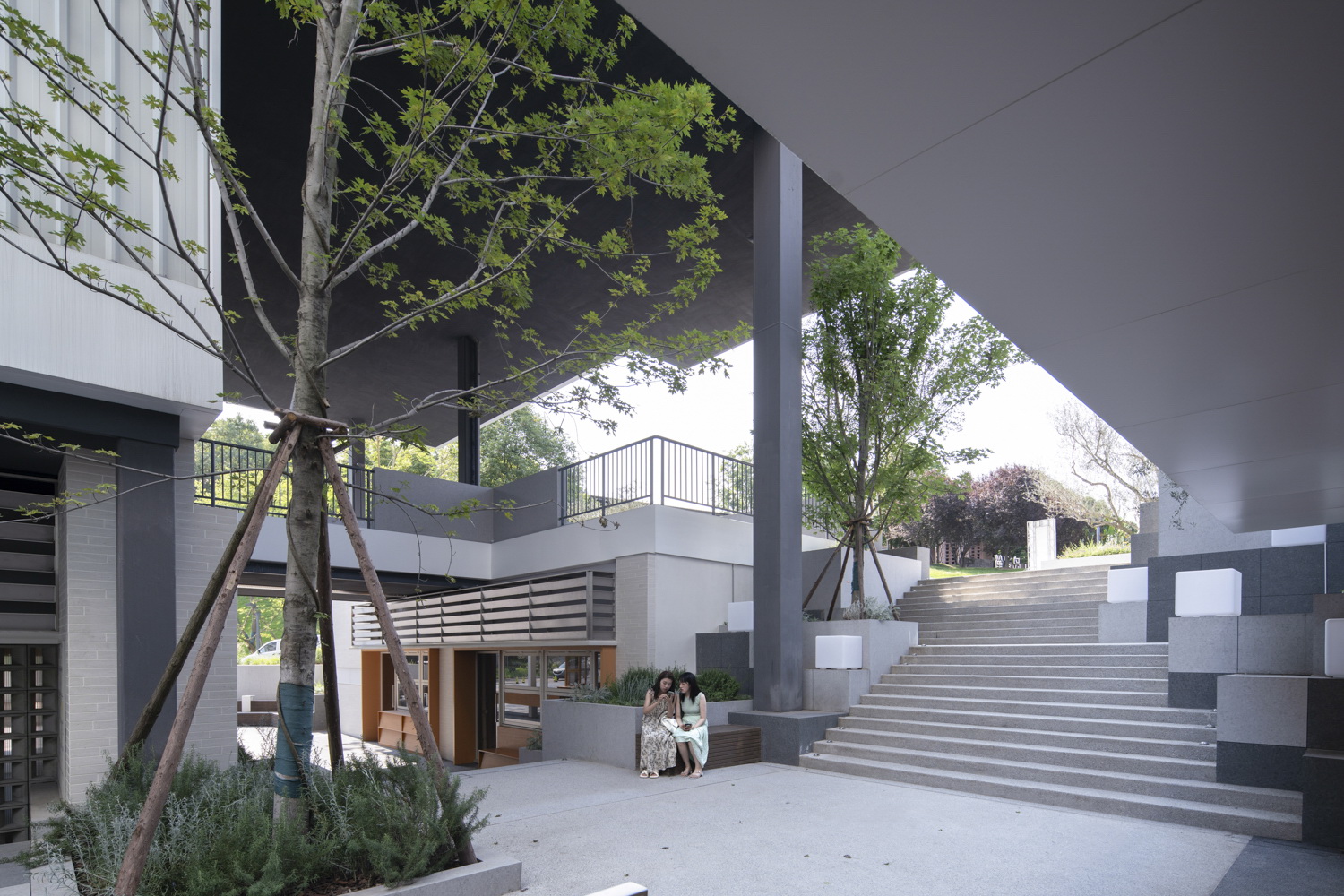
▲中轴与灰空间的串联
▲ Connection between the central axis and the dormant spaces
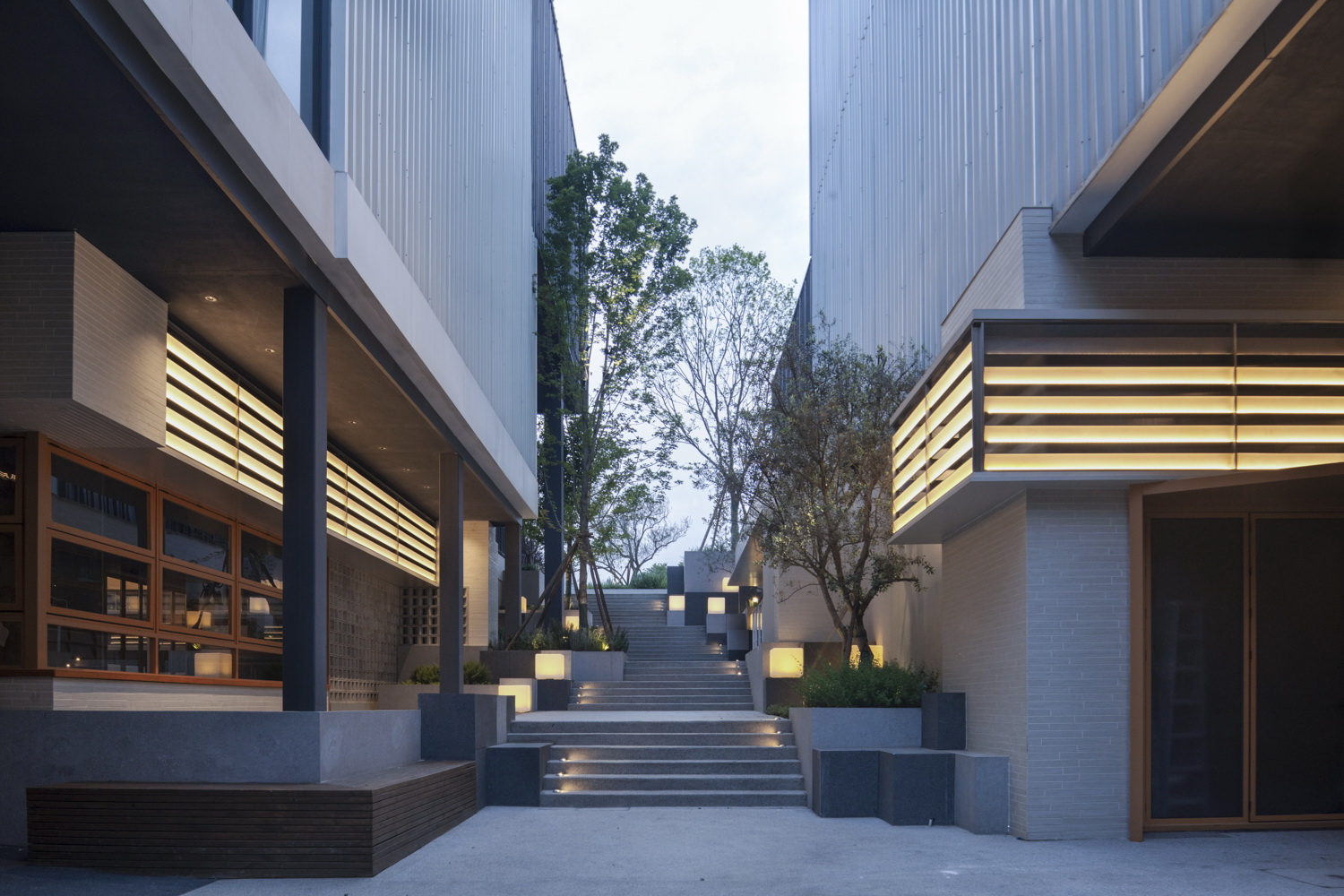
▲中轴与挂面铺的密切互动
▲ Interaction between the central axis and the retail spaces
随着拾阶而下,人流动线与主力店前广场形成汇聚,在交谈驻足中,达成了对项目空间核心的了解。从主力店中通道向湖边视线,业主设置艺术装置驻留,为整个湾区及通道形成一个强有力的主题昭示,而通道自身也形成了取景框。
As people descend the stairs, the flow of people converges with the front plaza of the main retail stores, creating a place for conversation and pause, which enhances the understanding of the core spaces of the project. From the passage in the main retail store to the lakeside, the owner has set up art installations, creating a powerful thematic symbol for the entire bay area and passage, which has also become a frame for sightseeing itself.
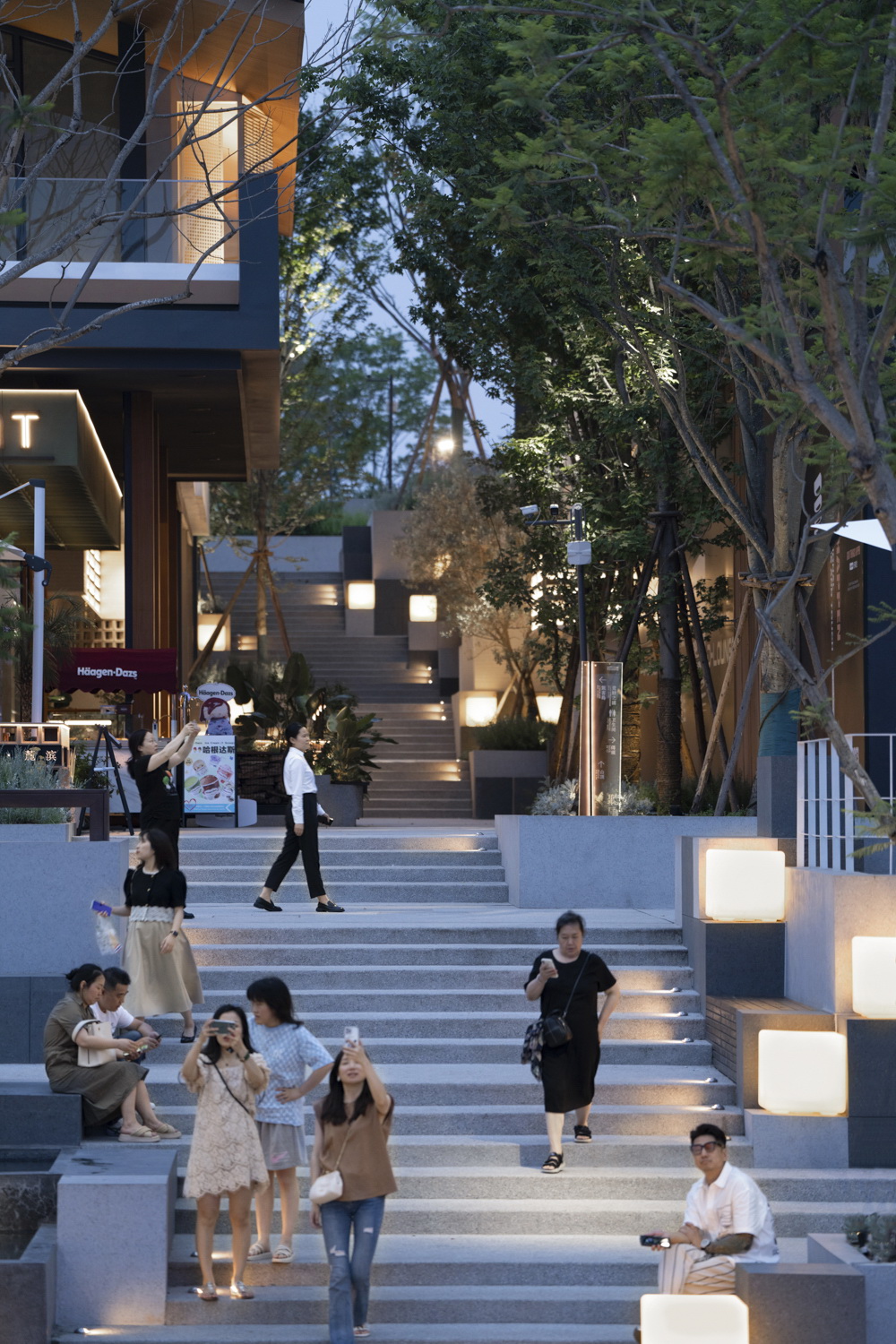
▲近湖区的中轴台阶成为社交聚集的场所
▲ Central axis staircase area as a social gathering place
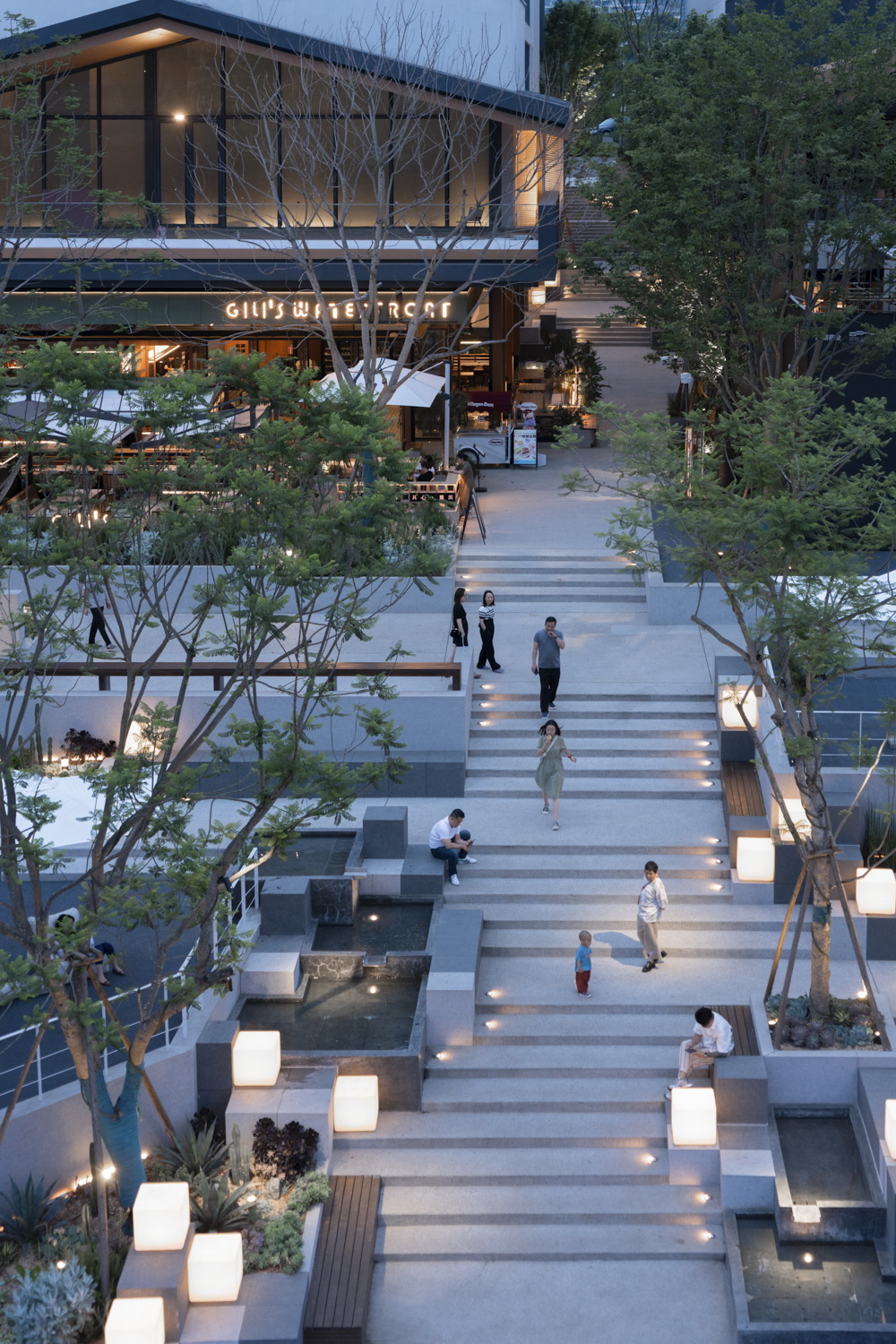
▲中轴俯视图
▲ Top-down view of the central axis
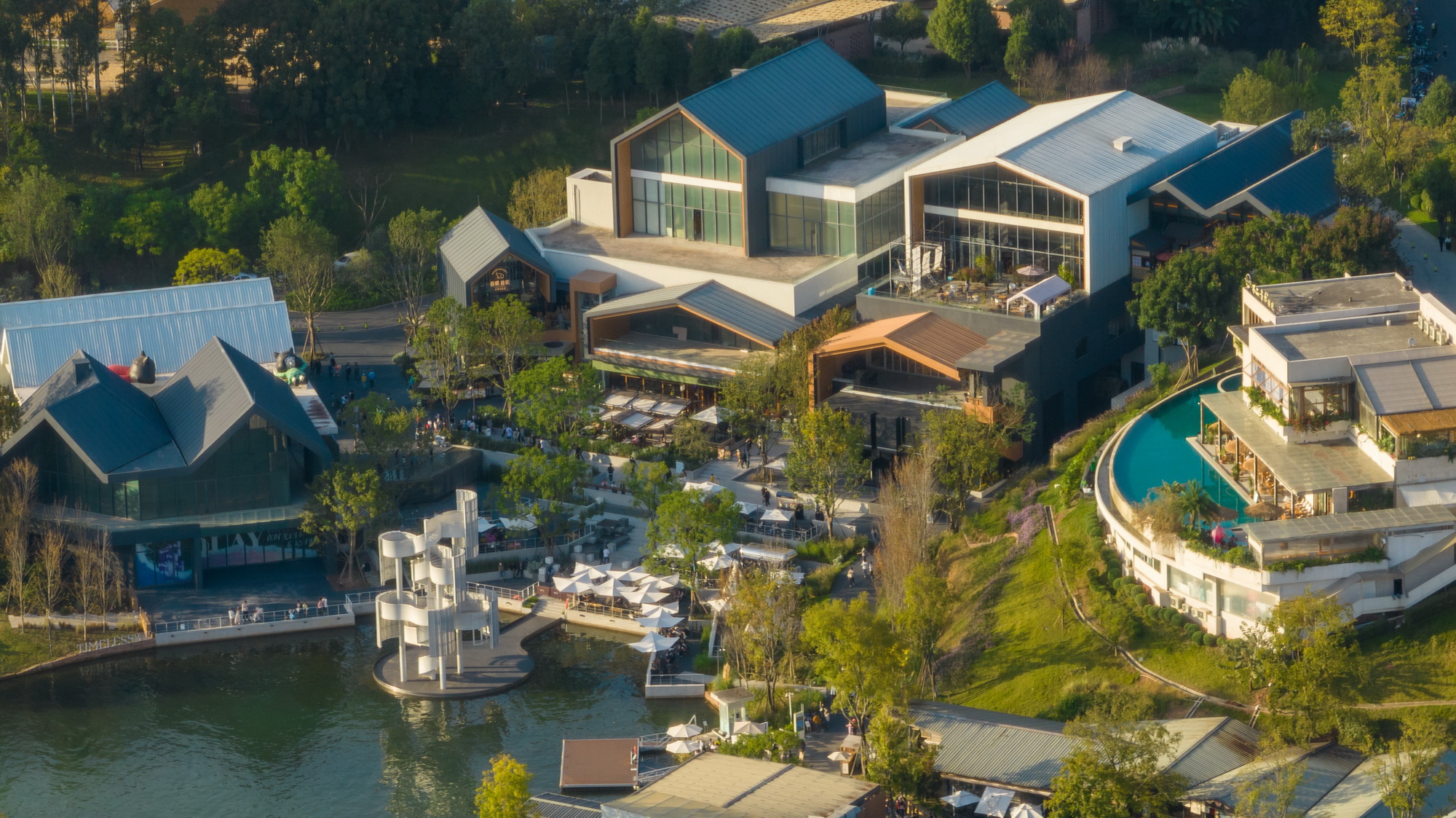
▲活动期间滨湖区鸟瞰
▲ Aerial view of the lakeside area during events
靠近湖区,与一期自然退台形成鲜明对比,简洁硬朗的几何线条划分明确的退台空间。因为此区域的滨湖资源尤为珍贵。所以在规划之初,我们尝试研究如何将滨湖资源在内湾区最大化利用。通过多轮探讨,综合商家、游客、景区等多方需求,将湾区滨湖水域释放给公共空间,但兼顾商家、商业活动的使用,并将街区、景区主题活动空间也融入进来,日常也是外摆的运营区,是做一个复合功能叠加的空间,最大化将景观资源得以功能化利用。
In the vicinity of the lakeside, a contrasting and distinct natural retreat is formed in comparison to the first phase. With clear and concise geometric lines, the space is divided into distinct retreat areas. This lakeside area holds particular value. Therefore, during the initial planning stage, efforts were made to maximize the utilization of lakeside resources in the inner bay area. Through multiple discussions and considering the needs of businesses, tourists, and the scenic area, the lakeside water area was allocated to public spaces while accommodating commercial activities. The design also integrated the block and theme activity spaces of the scenic area, creating a multi-functional space for daily outdoor operations and maximizing the utilization of landscape resources.
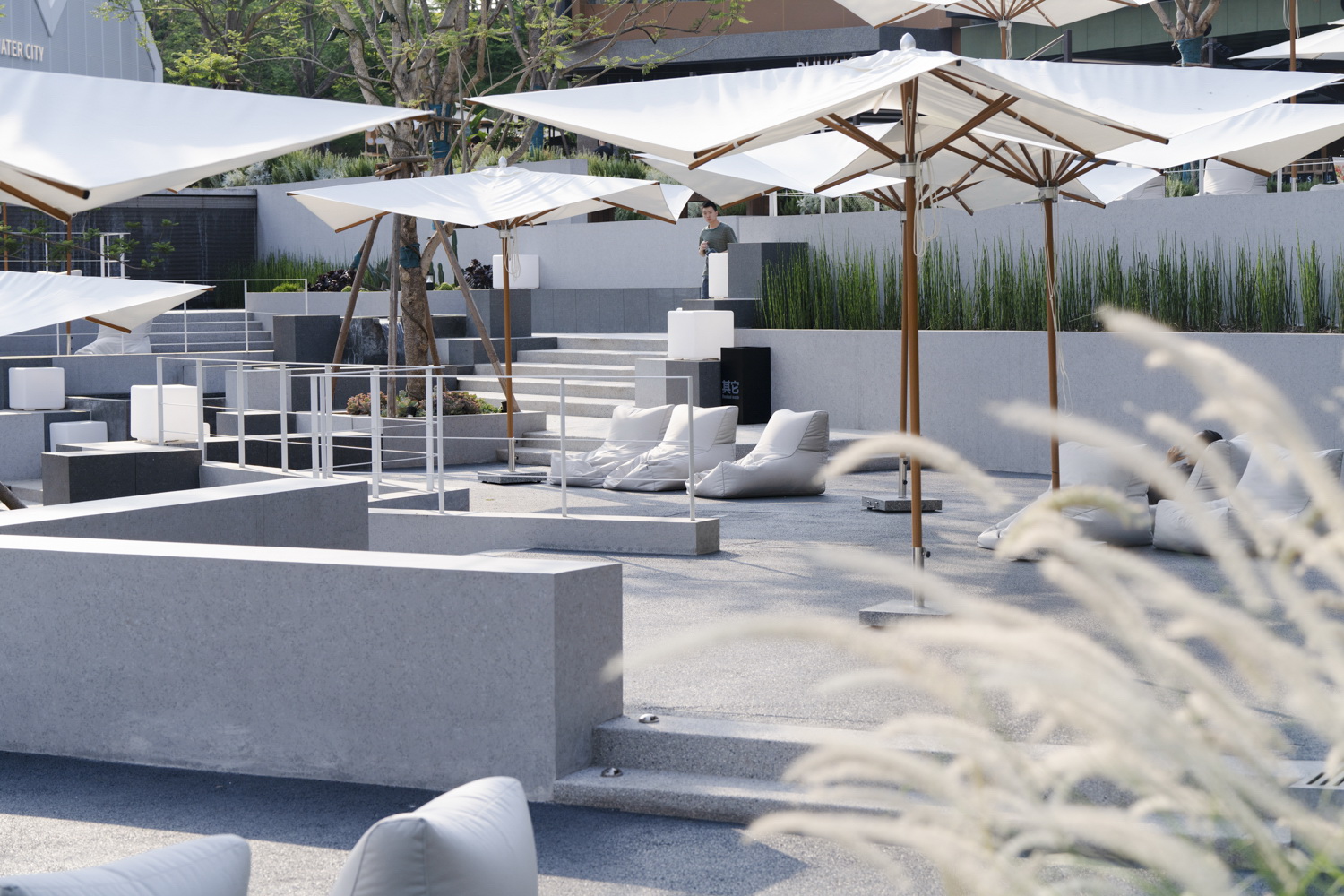
▲日常状态的滨湖外摆区
▲ Daily lakeside outdoor display area
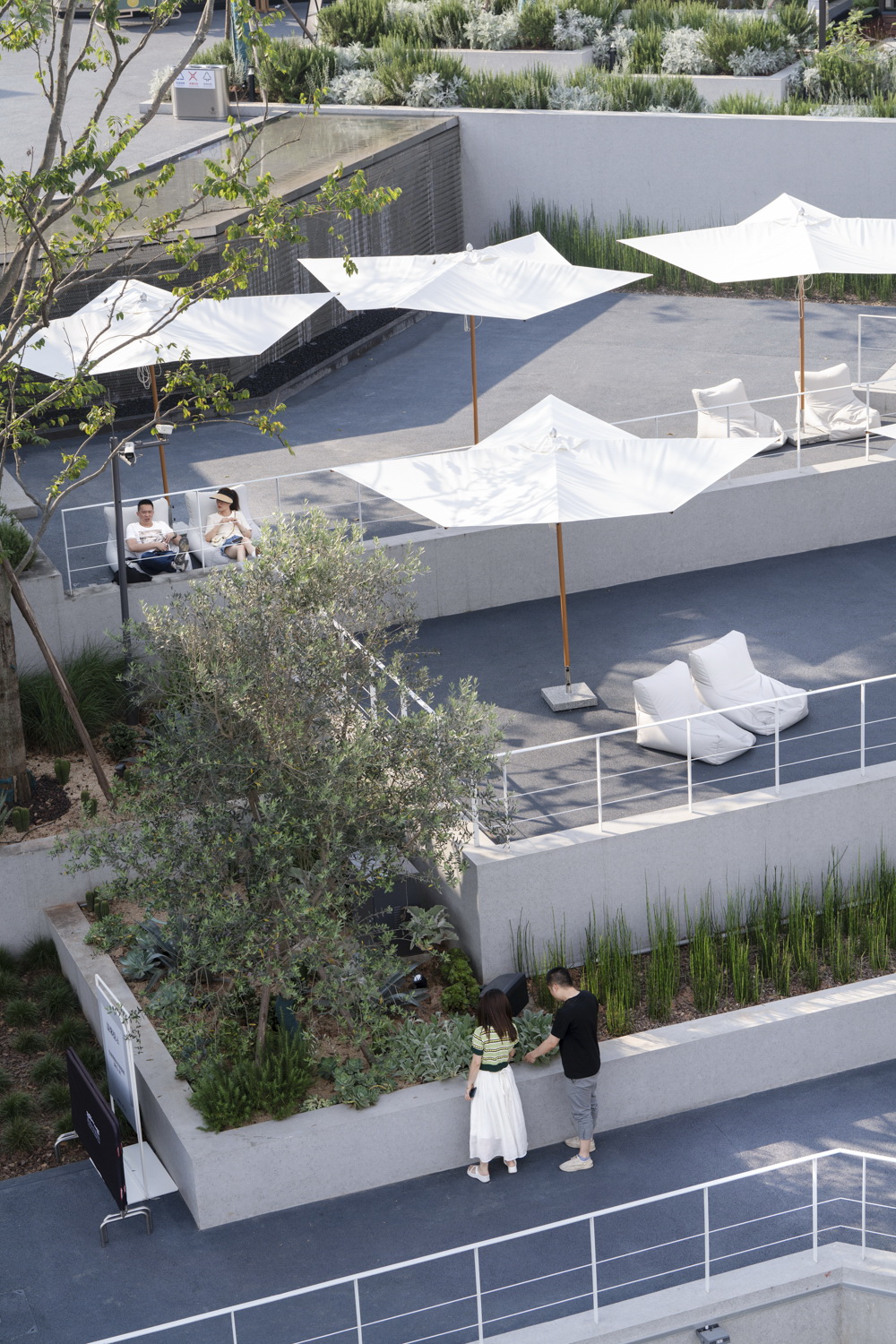
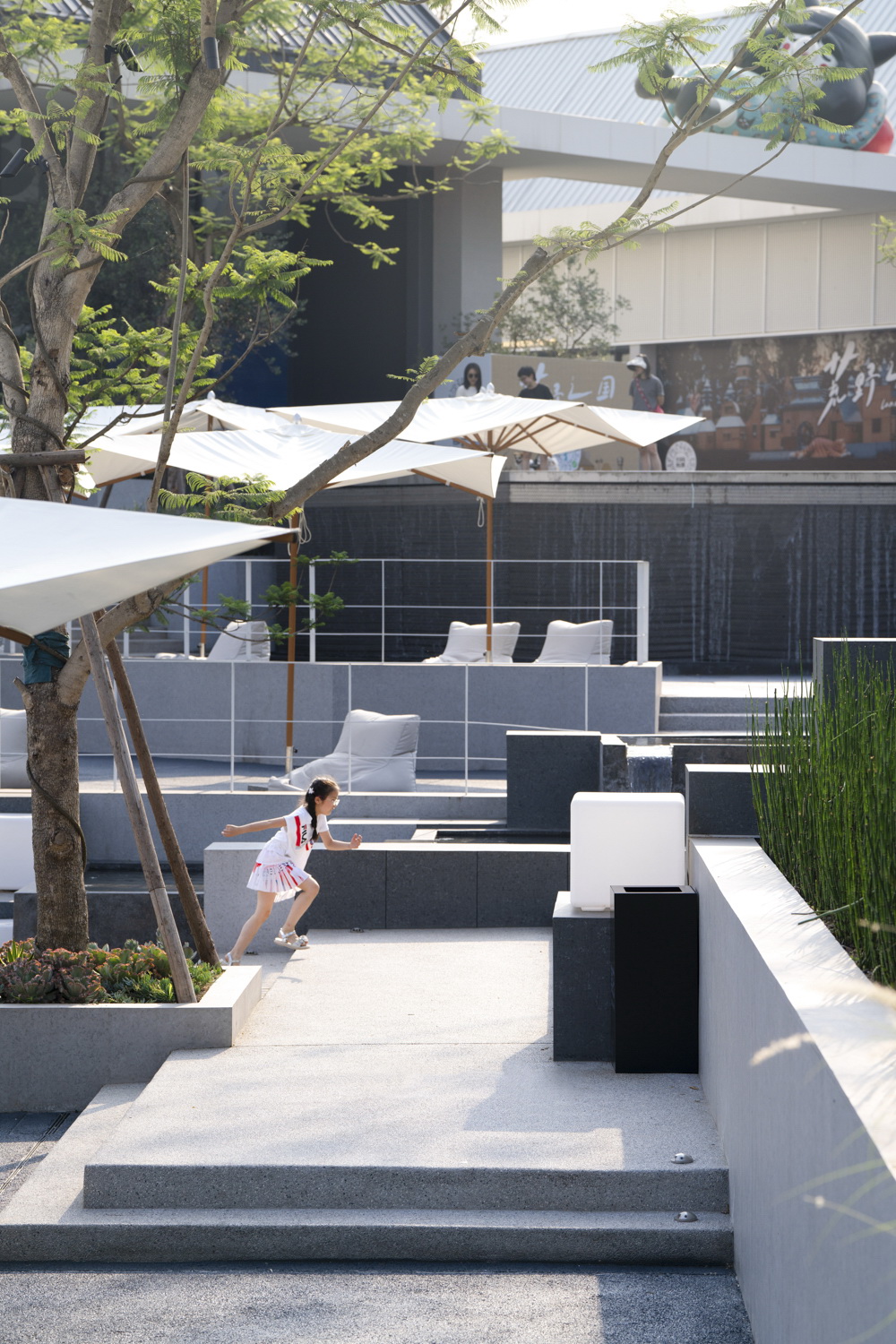
▲兼顾游客互动的公共性
▲ Balancing public interaction for tourists
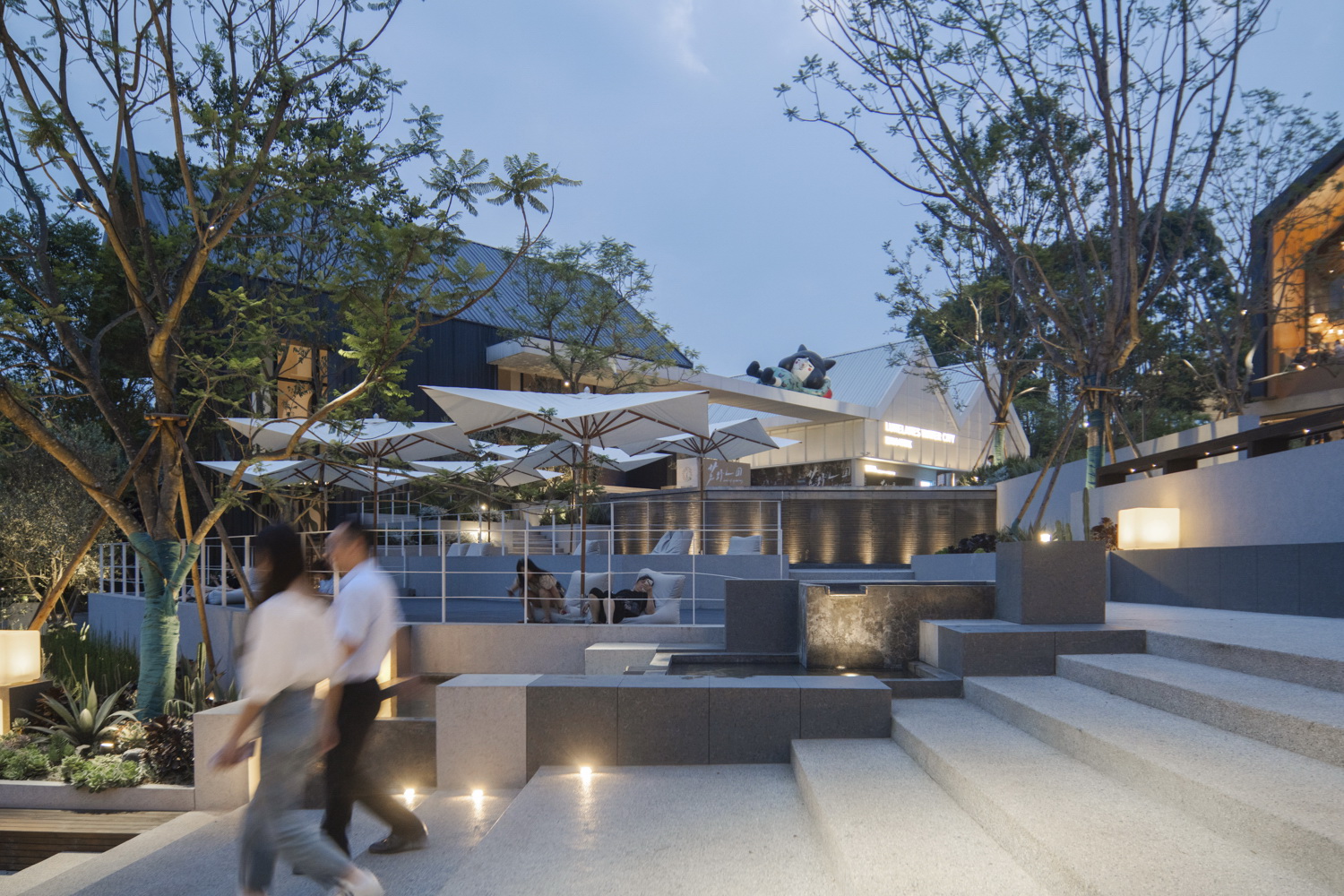
▲通道与滨湖外摆区关系
▲ Relationship between the passage and the lakeside outdoor display area
项目低成本建造原则,过程中对于材料及实施建造要求以低技、严格工程控制为前提,固在设计中,尝试以大量柔性材料及质感材料来作为空间、氛围营造的基础,以点植乔木、水景作为功能空间中的氛围打造。为游客及来访者营造富有变化的休闲舒适的目的地。
The project adheres to the principle of low-cost construction, with an emphasis on low technology and strict engineering control concerning material and implementation requirements. Thus, a large number of flexible and textured materials were utilized as the basis for creating a spatial atmosphere. Planting and water features were also incorporated to establish an ambiance within the functional spaces. The goal was to create a destination that offers a diverse and comfortable leisure experience for visitors.
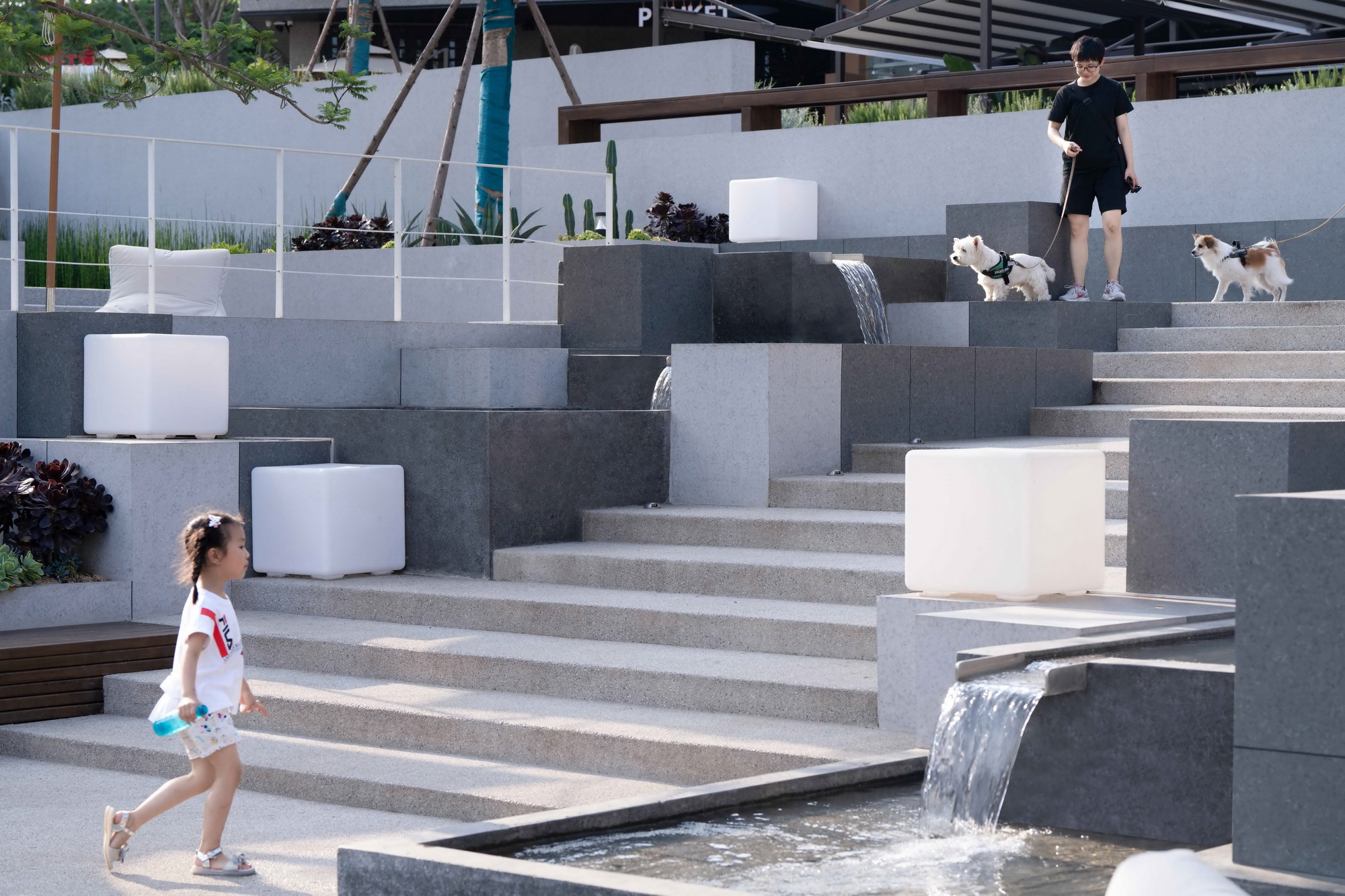
▲中轴跌水
▲ Water feature along the central axis
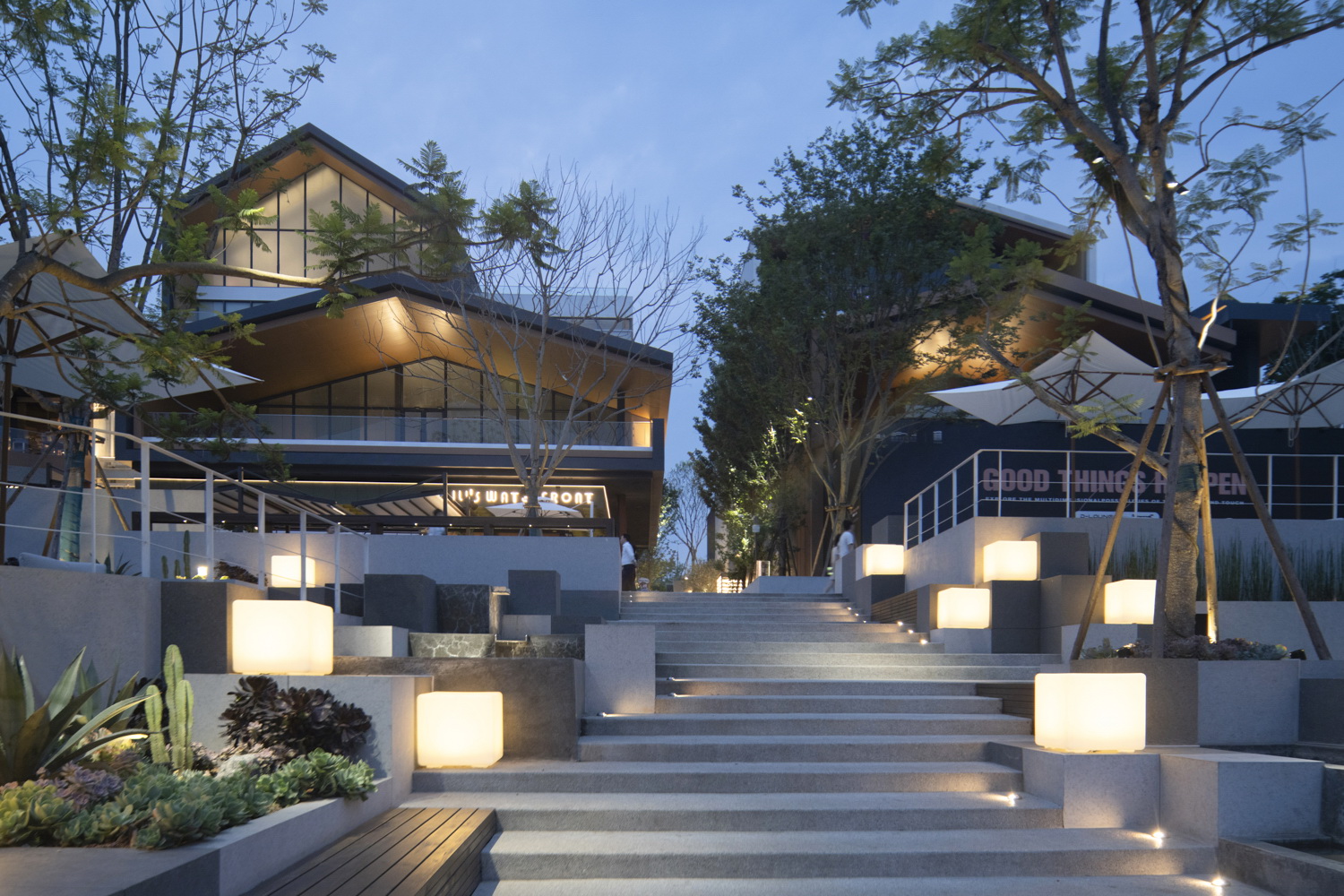
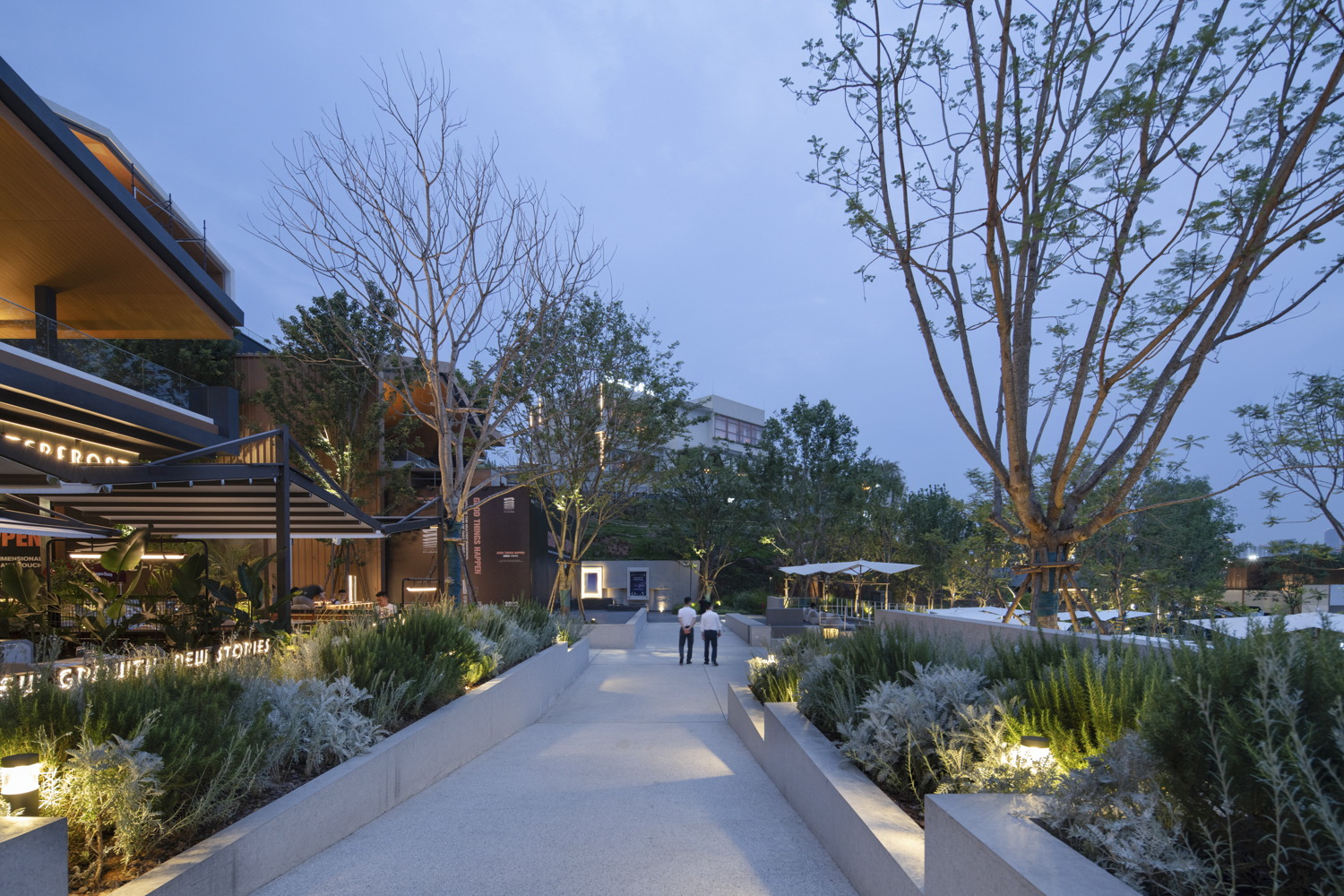
▲景区通道夜景
▲ Night view of the scenic area passage
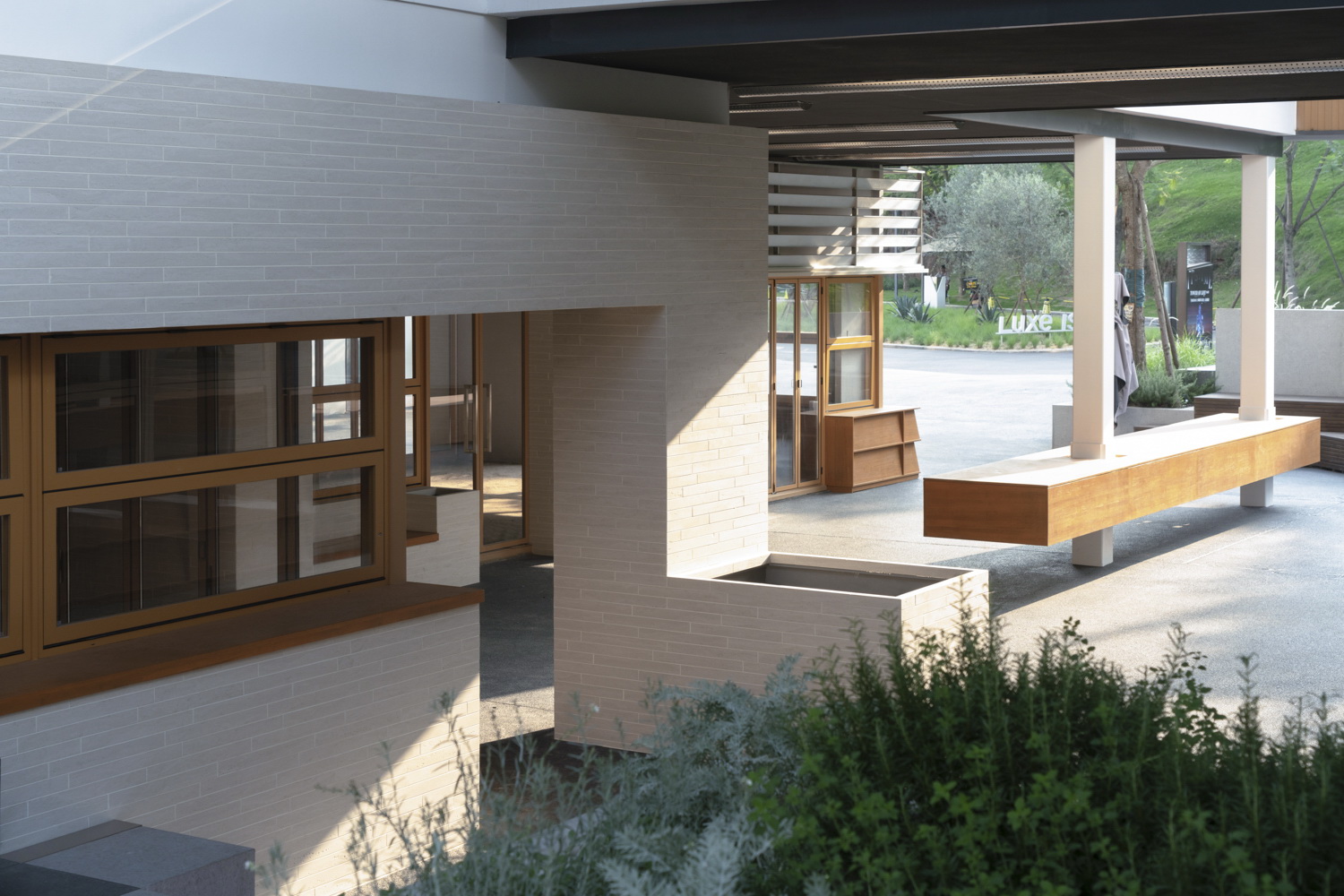
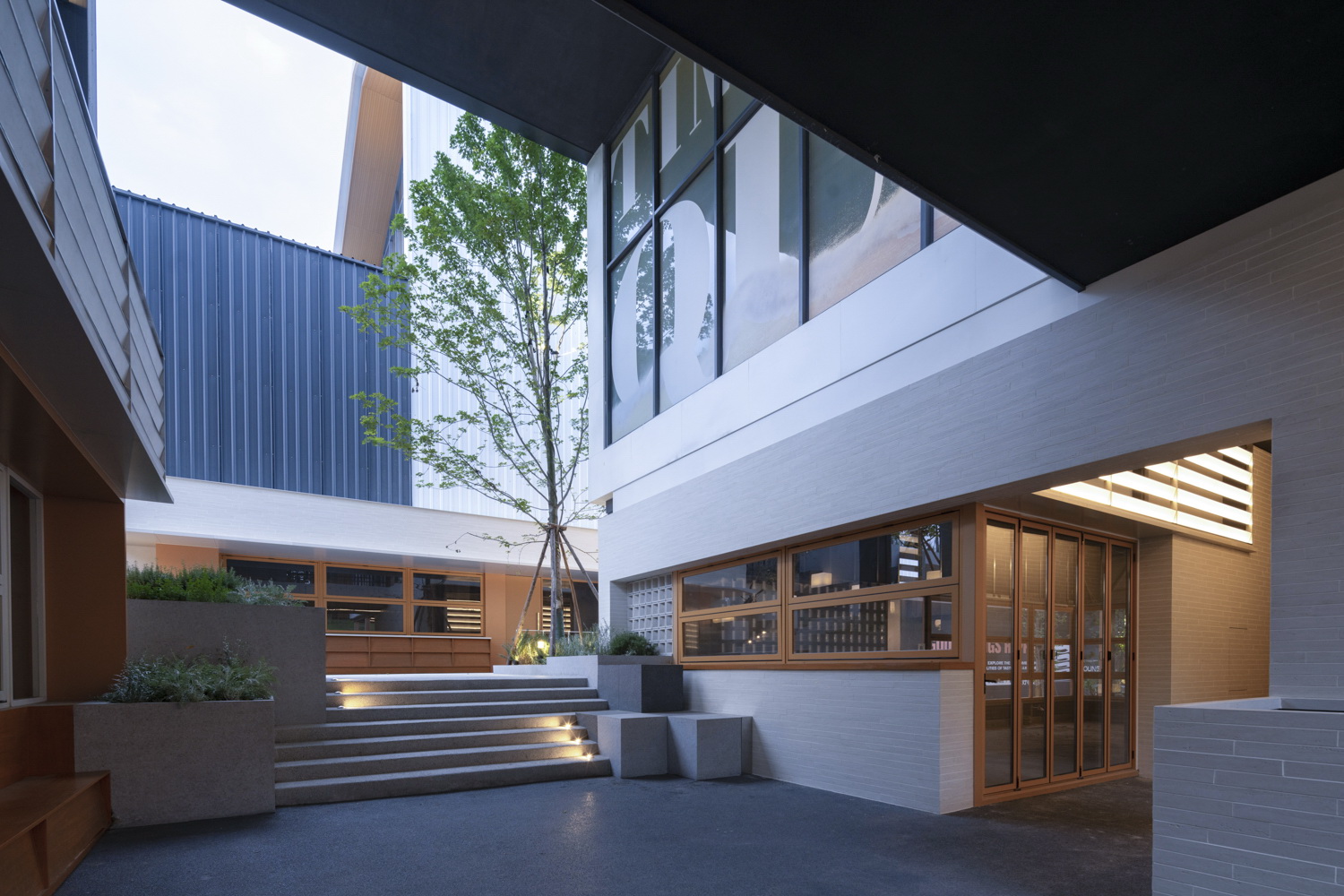
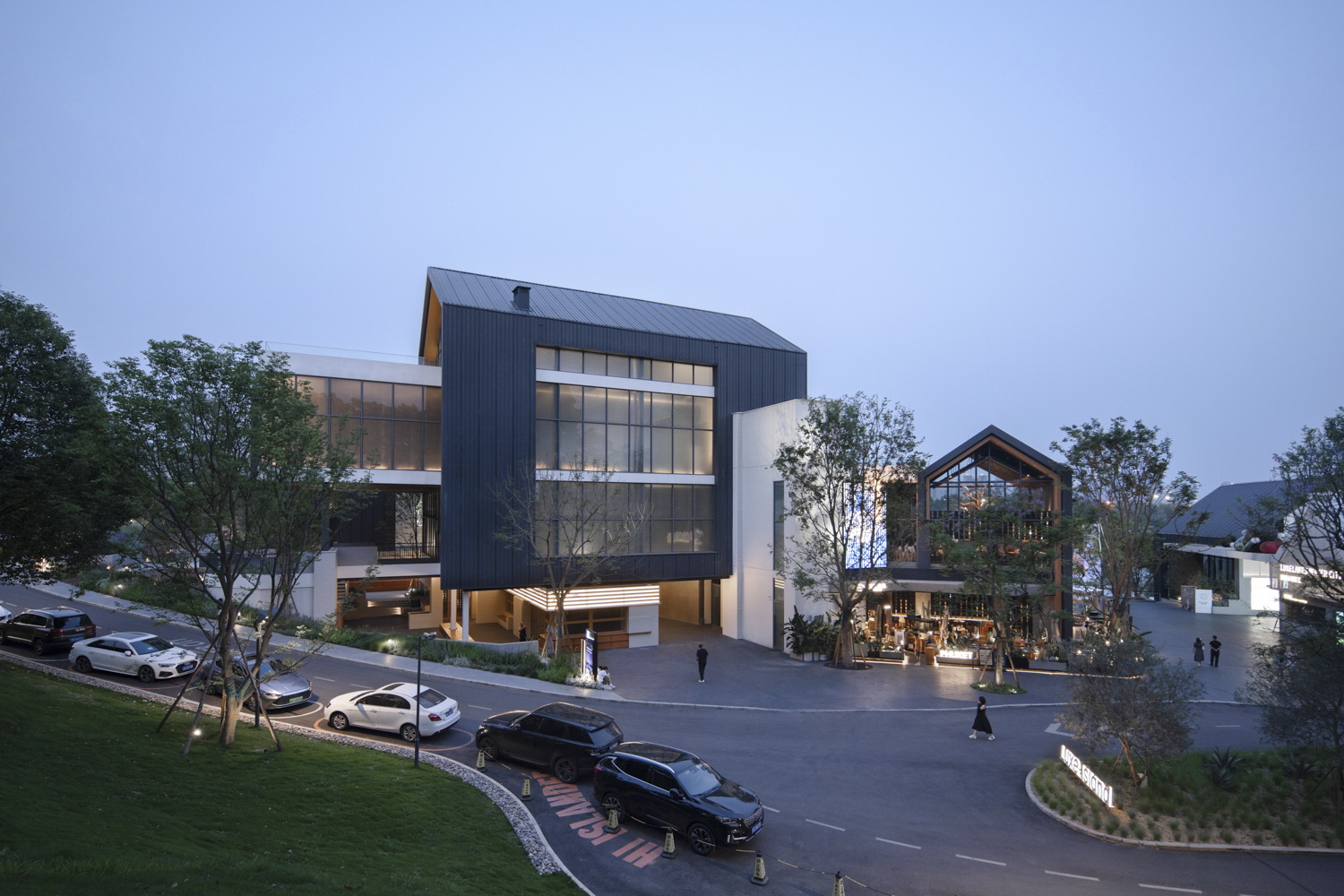
▲灰空间串联的景区主入口广场
▲ Plaza at the main entrance of the scenic area connected by the dormant spaces
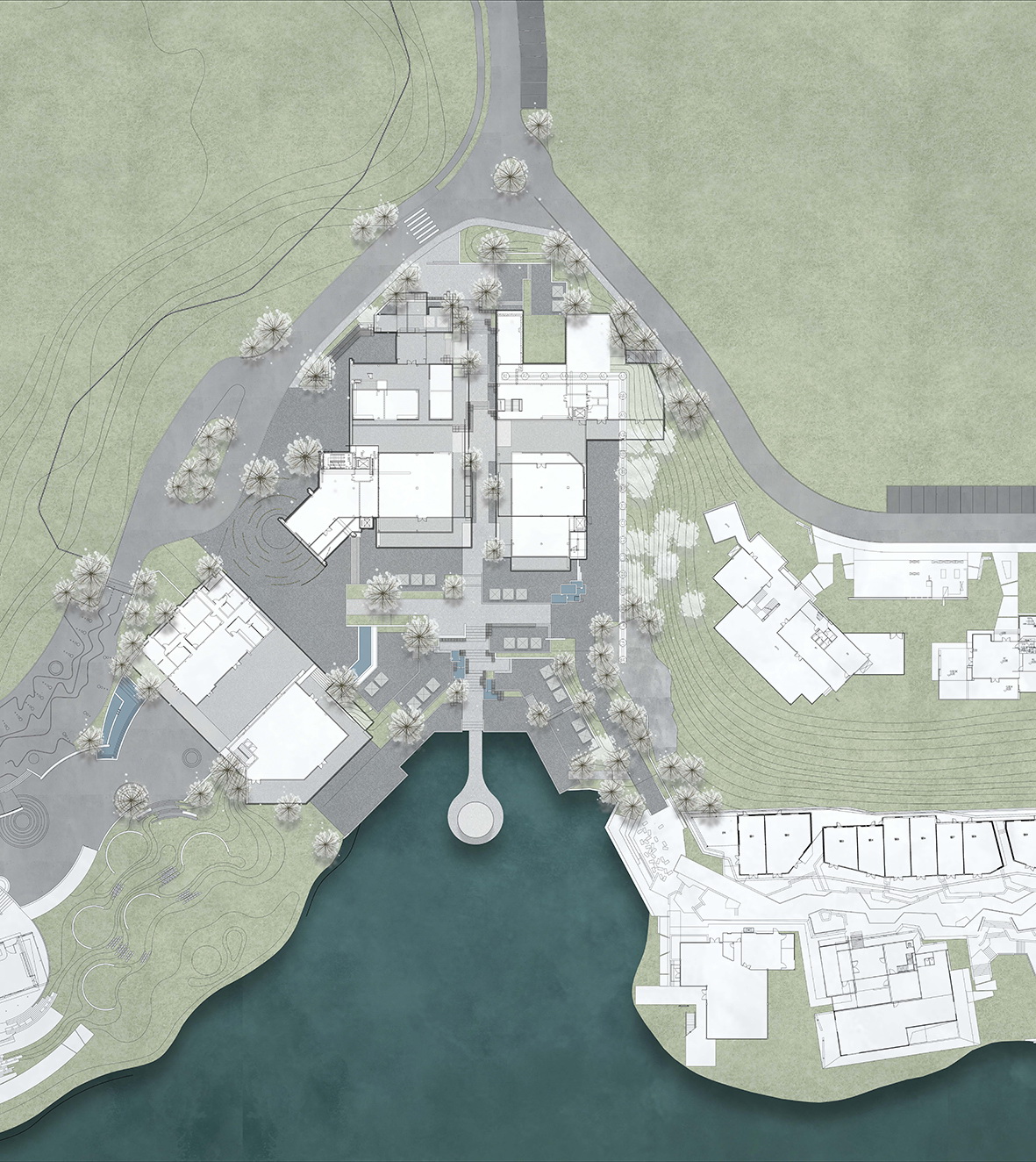
▲项目平面图
▲ Project floor plan
项目名称:成都天府麓湖美食岛二期
景观设计:昱道景观
完成年份:2023
项目面积:9700㎡
设计团队:龙昱杉 赵鑫源 羊彦 周梦琳 冯裕雯 任文 朱雨橦 周佳苹 王鹏 罗震川 陈湘 许博瑞
摄影版权:存在建筑 孙庆 昱道景观
建筑设计:四周建筑
灯光设计:BPI
业主方:万华文旅 万华商管
施工方:成都鼎鑫建筑工程有限公司
运营方:万华商管
Project Name: Phase 2 of Chengdu Tianfu Luhu Food Island
Landscape Design: Yudao Studio
Completion Year: 2023
Project Area: 9700㎡
Design Team: Long Yushan, Zhao Xinyuan, Yang Yan, Zhou Menglin, Feng Yuwen, Ren Wen, Zhu Yutong, Zhou Jia Ping, Wang Peng, Luo Zhenchuan, Chen Xiang , Xu Borui
Photography Copyright: Existing Architecture, Sun Qing, Yudao Studio
Architectural Design: Sizhou Building
Lighting Design: BPI
Owner: Wanhua Culture and Tourism, Wanhua Fund Management
Construction: Chengdu Dingxin Construction Engineering Co., Ltd.
Operation: Wanhua Fund Management